Gulab Jamun is arguably one of the most popular Indian sweets that’s made pretty much through the year in the country. Since Gulab Jamuns are easy to make in larger quantities, it’s a popular dessert served warm with a scoop of ice cream at Diwali, weddings, parties, festivals, etc.
I really can’t think of a better day to share this delicious Gulab Jamun recipe using Khoya (or Mawa) than to start off a brand new year 2012.
One of the most common question I get when discussing Indian Sweets is “what’s that soft brown ball that’s very sweet and soaked in sugar syrup?”. Probably because gulab jamun is served at practically all Indian buffets, it’s not hard to guess which sweet they are talking about!
For all the cooking that I do, I had never tried to make gulab jamun at home, not even with the readymade boxed mix. Amma has mentioned how her mom, my aatha, makes gulab jamun with fresh, homemade khoya (mawa) and since then, I’ve wanted to try it the same way.
I realised that if I waited to make my own khoya, the gulab jamuns will never happen so I used store-bought khoya. It’s usually kept frozen so make sure to bring to room temperature before using.
Oh and by the way, khoya smells amazing. Go ahead and sniff it while it defrosts.
Key things to remember for success while making Gulab Jamun at home.
- Khoya needs to be completely soft and at room temperature
- Use a light hand when kneading the dough
- Don’t make the dough balls super smooth before frying, this can cause them to break or crack. Just roll them 90% smooth with some rough spots on the surface
- Make sure the oil is hot but not smoking hot. Ensure you fry long enough so that the inside cooks too. Keep regulating oil temperature
- The sugar syrup consistency is important but not critical, in my opinion. It shouldn’t be too thick, otherwise it won’t enter the gulab jamun and make them soft
Ok, maybe I made all of that sound intimidating but it really isn’t. Go ahead, give them a shot.
This recipe also features in the list of quick and easy Diwali Sweets recipes
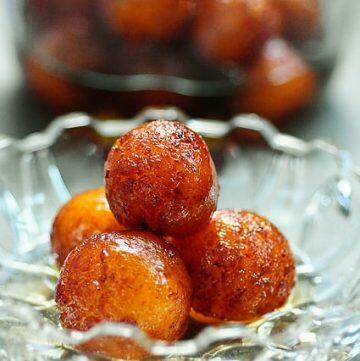
Gulab Jamun Recipe
Ingredients
For the jamun:
- 1 cup grated khoya or mawa
- 1/3 cup plain flour or maida
- ~ 1/2 cup water
- A big pinch of salt
- Oil or ghee to deep fry
For the Sugar Syrup:
- 2.5 cups sugar
- 1 cup water
- 3-4 pods of cardamom crushed
- 2 drops of rose water optional, although the name of this sweet has “rose / gulab” in it
- A few strands of saffron optional
Instructions
- 1. Grate the khoya. Mix this with the plain flour and salt.
- Note that if you are using store-bought khoya, this mixture will be quite dry. If using fresh, homemade khoya, it will be moist so you need less water for the next step.
- 2. Add sufficient water (I used around 1/2 cup) and form a stiff dough. It shouldn’t be sticky. If it is, add a bit more flour and incorporate without kneading too much.
- 3. Make into small marble-sized balls. Remember to start small because the jamuns will expand on frying and further on soaking in the sugar syrup. You don’t need to make the balls super smooth, just into small circles of even sizes (see notes above)
- 4. Heat oil to just short of smoking point and add the dough balls one by one gently. Don’t overcrowd the dough balls, fry a few at a time. This also ensures that the oil temperature doesn’t drop too much while frying.
- 5. Fry all the jamun until golden brown on medium heat, remove with a slotted spoon, and set aside.
- 6. To make the sugar syrup, mix the water and sugar and set on a medium-low flame. Stir until the sugar has dissolved completely and the mixture comes to a slow boil. Add the crushed cardamom pods, saffron and rose water if using.
- 7. Let the sugar syrup cool for about 5 mins and then dunk in the fried gulab jamun.
- 8. Partially close the pan and let the jamun soak in the sugar syrup for atl east 3-4 hours before serving.
Notes
- Gulab jamun can be served warm or cold. If warm, it tastes excellent with vanilla ice-cream.
- If the centre of the jamun is hard, that usually indicates it's undercooked and didn't fry all the way through
- If the entire jamun feels hard and doesn't seem to be absorbing the syrup, this means the dough balls got over-fried or the dough didn't have enough moisture.
- I recommend frying a small. batch first to make sure the dough is all fine and the inside is cooking, before you proceed with the rest
Gulab Jamun Step by Step Recipe
1. Mix the grated khoya with the flour and salt. If using store-bought khoya, this mixture will be quite dry. If using fresh, homemade khoya, it will be moist so you need less water for the next step.
2. Add sufficient water (I used around 1/2 cup) and form a stiff dough. It shouldn’t be sticky. If it is, add a bit more flour and incorporate without kneading too much.
3. Roll into small marble-sized balls. Remember to start small because the dough balls will expand on frying and further on soaking in the sugar syrup. You don’t have to make the balls super smooth, just into small circles of even sizes.
4. Heat oil to just short of smoking point and add the dough balls one by one gently. Don’t overcrowd the dough balls, fry a few at a time. This also ensures that the oil temperature doesn’t drop too much while frying. Consistent oil temperature is important for even frying of gulab jamun
5. Fry all the jamun until golden brown on medium heat, remove with a slotted spoon, and set aside. Don’t be alarmed if some of them crack or seem to split on the sides just a bit. If they split into two or disintegrate, time to rework the dough (see notes)
6. To make the sugar syrup, mix the water and sugar and set on a medium-low flame. Stir until the sugar has disssolved completely and the mixture comes to a slow boil. Add the crushed cardamom pods, saffron and rose water if using.
7. Let the sugar syrup cool for about 5 mins only and then dunk in the fried jamun.
8. Partially close the pan and let the jamun soak in the sugar syrup for at least 3-4 hours before serving.
Some of the sugar syrup gets absorbed by the gulab jamun but most of it remains as is so if you have any suggestions on how to use up leftover sugar syrup, please let me know. For now, I can only think of using it up for sweet godumai adai, substituting jaggery with the sugar syrup, which is what Amma does.

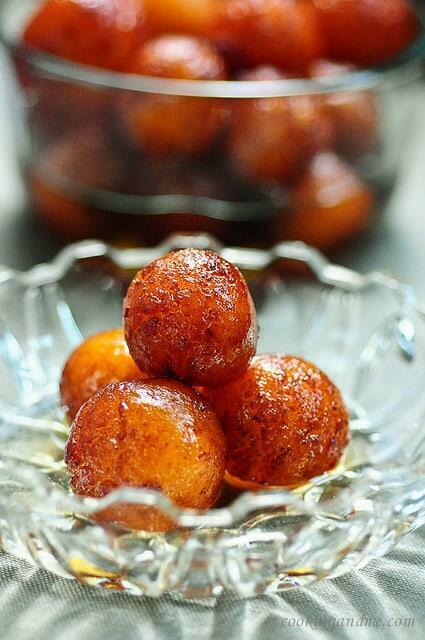
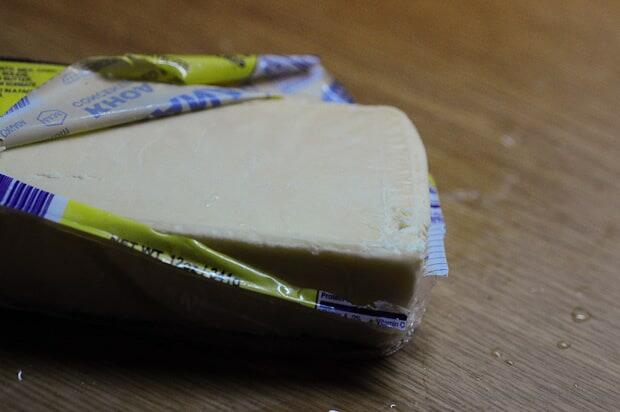
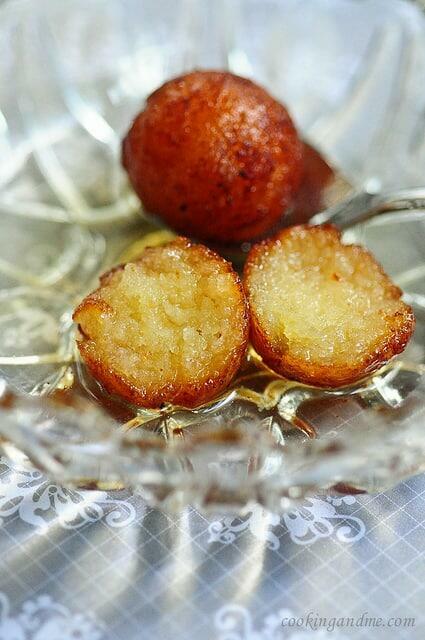
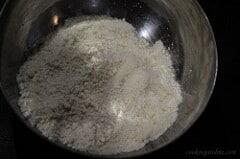
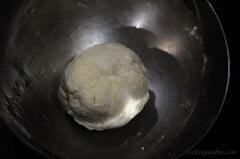
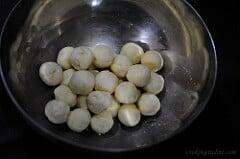
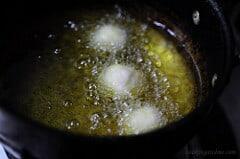
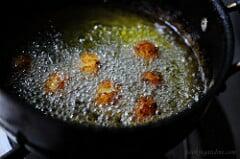
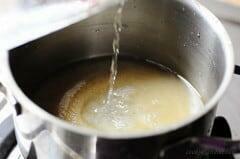
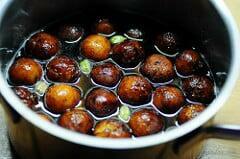
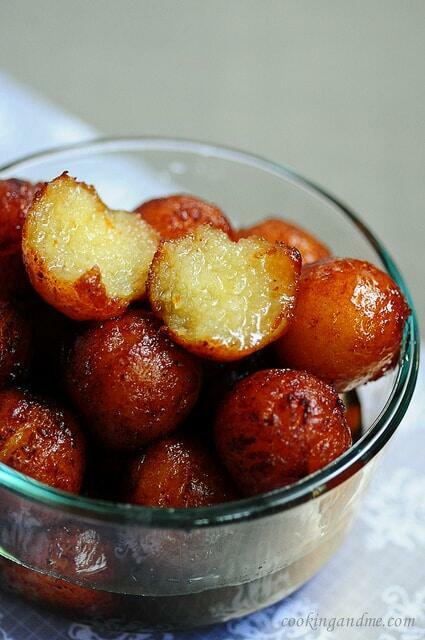
Great recipe from scratch. Do you know other recipes for Gulab Jamun in which we can use pancake flour or Milk powder and sooji.
I heard people use those ingredients for less cholesterol but don’t know how to make it. Please share if you know.
Thanks.
thanks PS, haven’t tried those yet
Looking too delicious. My mouth is filled with water.
thanks for the recipe. But I like to know what is khoya and how to make it, tq
khoya is solidified milk and to make khoya from scratch you need to boil and simmer full fat milk until it reduces to almost-solid state which will take about an hour or more. i buy khoya from the indian store which is pretty much the same thing. there's a picture above of the khoya
So tempting n perfect!
Lip smacking dear
Hi nags- This looks mouth watering !!! I want to try making it but I am extremely scared cos the last time I made gulab jamun I fried it in oil that added a horrible taste! What oil did you use? Does it make a big difference if you use Ghee?
if you don't like the flavour of oil, use ghee. my mom uses a mix of ghee and vanaspati.
Hi Nags, I follow your blog to try new recipes and they all come out well. This Khoya jamun is my husbands favo sweet but I am unable to get readymade Khoya as i live in UK. Could you please share some recipe on how to make homemade Khoya? Thanks
you have to reduce milk to khoya by simmering in an open pan for an hour to hour and a half. it's tedious but the resulting khoya will taste awesome!
What a sweet way to begin a new year!hi nags,love ur blog.will definitely give the khoya jamuns a try.keep going girl. andhra kitchen